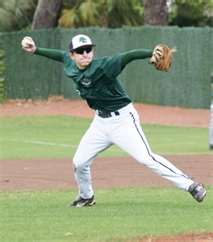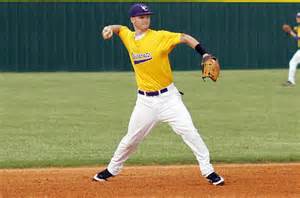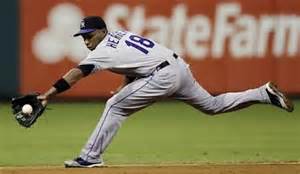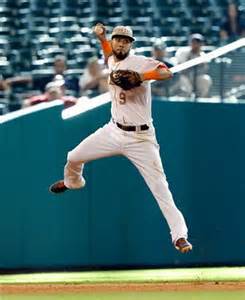Baseball Infield Tips - Shortstop Position
When teaching most Baseball Infield Tips they can be general in nature, applying to all infield positions equally, all infielders follow the same principles of how to field a ground ball, or they can be position specific which is designed for the uniqueness of playing first and how to hold a runner close.
We’ll be learning initial and advanced skill factors involved in playing the baseball infield and since peoples’ discussions of the infield usually begin with what is known as the “Middle Infielders,“ we’ll begin our lessons with baseball infield tips for the middle, specifically the Shortstop position.
The position of Shortstop and Second Base, are so inter-dependent on one another’s interaction and the fact so many of their responsibilities mirror one another, that they are usually talked about as a tandem, but we’ll explore each position separately, then in unison in the world of Middle Infield.

Come Up Throwing - Baseball Infield Tips
Shortstop: and baseball infield tips
The shortstop is at times referred to as the “Little General” of the infield, while although the Catcher maintains supreme control, the SS is the infielder normally assigned the responsibility of directly receiving signs from the dugout and relaying them to the other infielders and outfielders, such as playing at double play depth, playing in at the corners, or an infield shift.
Normally in the younger age brackets of players, the coach himself will most likely give verbal instructions on any infield responsibilities, but it is your job as a Coach to teach the strategy behind your decisions and having the forethought of teaching your infielders to memorize 1 or 2 basic signals, offers them a head start on employing more complex strategies they will later encounter.
Physical Requirements of a Shortstop:
There are standard skills, catching, throwing, running, involved with playing each baseball position, infield and outfield, but as players mature and the field size expands, certain exceptional required skills become more position specific and such is the case with playing the shortstop position.
I’m not saying you can not play the shortstop position without these skills, but normally there are two (2) essential physical skills required to become a shortstop at a high level of play, such as a select team or high school and above, and they are a Strong Throwing Arm and Range.

Strong Arm - Baseball Infield Tips
Don’t throw your arms up in despair and stop reading if you feel you do not possess these skills as natural abilities, both can be improved with practice and the skills you will learn in the future lessons. Remember the name David Eckstein, who was a major league shortstop with a water pistol for an arm, but he got the job done.
As a footnote I‘ll address right now … most people will argue the third baseman has the longest throw to first base, thusly requiring the strongest throwing arm in the infield, and I agree with that assumption on a normal basis, but often the shortstop must go deep into the hole (his right side) to field a ball, which makes the throw to first base farther than the third baseman. Thus the requirement for a strong and accurate throwing arm.
Which brings baseball infield tips to the next qualifying skill of the shortstop … exceptional quickness and range.
As with all fielders, infield or outfield, players are required to catch any baseball, grounder or fly, fair or foul, which they can get to. Simple enough philosophy, but this responsibility requires the shortstop to be capable of traveling far to his left, as far as directly behind second base, and far to his right extending behind the third baseman all the way into foul territory to the stands or out of play.

Baseball Infield Tips - Range to the Left
Obviously, especially on a full sized baseball field, this is a very large piece of real estate the shortstop must have the capability of patrolling, requiring exceptional range and arm strength. Again, we’ll learn skills such as taking the “direct line” or “surrounding” the ball which will help the slightly slower athlete.
Concerning the standardized skills, all infielders are required to have a sure glove, but the shortstop must also possess soft hands, capable of fielding ground balls and quickly retrieving the ball from the glove and unleashing a throw, as bobbled catches and hesitation will kill a double play opportunity, either at the origination point or at the relay.
He should have quick and sure feet for turning double plays, and although his footwork is normally not quite as intricate as that of the second baseman, he still must be able to make a strong throw while avoiding an incoming base runner who is intent on knocking him into left field.
Learning How to Make the Play Deep in the Hole: Baseball Infield Tips
Since the play deep in the hole is quite possibly the most difficult play the shortstop encounters, let’s learn the step by step procedures and methods on which to drill in order to improve your skills and allow you to make this play.
First of all, you must realize the problems you must overcome in order to make the play deep in hole, then know how to overcome them.
1. The first problem of course is simply getting to and catching the ball before it goes into the outfield.
2. You’ll have to regain balance as you’ll be leaning far forward.
3. You’ll have to overcome your Forward Momentum, which will be extreme.
4. You’ll have to figure out how to make a strong, accurate throw.
Looks pretty intimidating, but it’s possible. Let’s learn how.

Baseball Infield Tips - Range to Right
There are Three (3) Basic methods for making the play from deep in the hole, and certain variables while making the play will exclude some methods. It’s your job to immediately realize what may or may not work.
Method One: Fielding the ball with a backhanded catch, waist high or above, which as you’ll see is very important, your head will be above or only slightly ahead of your hips, therefore you’ll be more or less balanced.
Your best method is to immediately stop your momentum away from first base, by firmly planting your right foot into the ground, recoiling and throwing from the set position.
Depending on the fielding position and the speed of the runner, there may or may not be time to stop your momentum, reverse it, then crow hop before throwing. It’s 80% arm strength.
Method Two: Should you field the ball below waist level, your head will be too far in front of your hips and you’ll be off balance and unable to stop your forward momentum by setting your foot without either falling completely down or at the least, stumble forward, which will eliminate any chances of throwing the runner out.

Airborne to Stop Momentum - Baseball Infield Tips
For this method after fielding the ball, you must first quickly straighten your body, while still moving away from first base, You won’t be able to stop or reverse your momentum away from first base, so your next best option is to Suspend the forward motion, by leaping into the air.
You must simultaneously be twisting the upper half of the body towards the target in order to make the throw while airborne, as there’s nothing touching the ground to assist changing your direction.
This throw is 100% arm strength and few shortstops short of major league caliber can make this play.
Method Three: Should you field the ball below the knees you are at the mercy of nature as you can not stop the centrifugal force your forward momentum has produced in time to make the put out. At this point you have two options:
(1.) Eat the ball and be glad you stopped it before it went into the outfield, which in some cases is an excellent run saving play….. Or
(2.) Forget stopping or slowing down your forward momentum, but rather Redirect it to benefit you.
Method 3 Steps:
1. Upon catching the ball as quickly as possible begin raising your upper body position …
2. Reasonably balanced … Pivot on your left foot beginning to turn yourself towards first base … unleash a throw as soon as your right foot hits the dirt which will continue your re-direction or spin towards first base.
In other words you’re allowing the centrifugal force to turn or spin your body all the way around changing the direction you are traveling.
The only way an athlete can accomplish this play is practice, practice and more practice, because there are variables involved which are different for every person.

Baseball Infield Tips - Staying Low
For instance I may not have any problem with focusing while spinning, while some one else may feel like he’s on a merry-go-round, or being shorter I can throw from a lower position. These are all things an athlete must become aware of in his own skill set, a coach can not set standards here.
Baseball Infield Tips to Baseball Drills

New! Comments
Have your say about what you just read! Leave me a comment in the box below.